In the wake of rising global temperatures and the ever-pressing challenges posed by climate change, the phenomenon of coral bleaching has emerged as a significant concern among marine biologists, ecologists, and environmentalists alike. A groundbreaking study published in the journal Coral Reefs sheds light on the intricate relationship between seawater temperature increases and the structural integrity of coral skeletons, specifically focusing on massive Porites lutea corals. By analyzing the effects of thermal stress on these coral species, researchers aim to understand the broader implications for coral reef ecosystems.
The research, spearheaded by Sinclair, Fitzer, and Greeves, delves deep into how rising seawater temperatures can lead to coral bleaching. This process occurs when corals expel the symbiotic algae, known as zooxanthellae, that provide them with essential nutrients through photosynthesis. The expulsion not only results in the whitening of the coral, indicating stress, but also jeopardizes the corals’ survival by depriving them of their primary food source. As water temperatures continue to rise, the likelihood of widespread bleaching events increases, raising alarms among marine scientists about the resilience of coral ecosystems.
Within the study, the researchers meticulously examined the aragonite structure of Porites lutea coral skeletons. Aragonite, a mineral form of calcium carbonate, is crucial for coral health, providing structural support. The integrity of this aragonite structure is vital not only for the corals themselves but also for the myriad of marine species that depend on healthy reefs for habitat. As coral bleaching becomes more frequent due to climate change, understanding how thermal stress affects this structural component is essential for predicting long-term outcomes for coral reefs.
The findings of the study reveal a concerning trend: increased seawater temperatures significantly alter the composition and mechanical properties of coral skeletons. As the temperature rises, the aragonite structure undergoes critical changes that could diminish the strength and durability of the coral skeletons. This weakening may result in the inability of corals to recover from bleaching events, rendering them more susceptible to diseases and further environmental stresses. The implications of these alterations extend beyond individual coral species to the entire biodiversity that inhabits these ecosystems.
The methodology employed by the researchers involved a combination of field studies and laboratory experiments designed to simulate the effects of elevated temperatures on Porites lutea. By closely monitoring changes in key material properties, the team could ascertain how temperature variations impacted skeletal density, rigidity, and overall health. Their approach underscores the value of interdisciplinary science in understanding ecological relationships and the importance of empirical data in shaping conservation efforts.
One of the most alarming aspects of this research is its intersection with global climate policies. As governments and organizations convene to discuss solutions to combat climate change, the implications for coral reefs remain a critical topic of discussion. The study’s findings serve as a call to action, urging stakeholders to prioritize coral health as part of broader climate mitigation strategies. Protecting coral reefs is not merely an environmental concern; it is a matter of global biodiversity and the health of oceans.
Moreover, this research emphasizes the need for increased awareness about how human activities contribute to climate change and, consequently, coral degradation. The pursuit of restoration and conservation efforts must be coupled with a commitment to reducing carbon emissions and protecting marine environments. The interconnectedness of climate systems means that local actions can have far-reaching consequences, and this awareness is vital in fostering a sense of responsibility towards marine habitats.
As coral reefs continue to face unprecedented challenges, the role of science and research becomes ever more crucial. Studies like the one conducted by Sinclair and colleagues provide a foundational understanding that can guide future conservation efforts. By meticulously documenting changes in the aragonite structure and its potential implications, researchers can inform policymakers and conservationists about effective strategies to safeguard these vital ecosystems.
The resilience of coral reefs is also tied to our collective actions. Engaging local communities in conservation efforts, raising awareness about the importance of coral ecosystems, and advocating for sustainable practices are integral to ensuring the survival of these underwater treasures. The narrative around coral bleaching needs to shift from one of despair to one of action, emphasizing the collective responsibility we bear in protecting the oceans.
In conclusion, the research on the effects of seawater temperature-induced coral bleaching on the aragonite structure of massive Porites lutea coral skeletons is a stark reminder of the fragility of marine ecosystems. As global temperatures continue to rise, understanding how this impacts coral health and the structural integrity of their skeletons will be pivotal in formulating effective conservation strategies. Through collaborative efforts, raising awareness about climate impacts, and implementing sustainable practices, we can work towards preserving the beauty and biodiversity of coral reef ecosystems for future generations.
The findings from this study highlight the urgent need for more comprehensive research into the complex interactions between climate change and marine ecosystems. As we delve deeper into understanding these mechanisms, we can better equip ourselves with the knowledge needed to combat the challenges that lie ahead.
Ultimately, the fate of coral reefs rests not only on the shoulders of scientists but also on the actions of societies worldwide. By coming together, we can strive to keep our oceans vibrant and teeming with life, ensuring that these invaluable ecosystems continue to thrive in the face of adversity.
Subject of Research: Impacts of seawater temperature on coral health and skeletal structure.
Article Title: The effects of seawater temperature-induced coral bleaching on the aragonite structure and material properties of massive Porites lutea coral skeletons.
Article References:
Sinclair, A., Fitzer, S., Greeves, S. et al. The effects of seawater temperature-induced coral bleaching on the aragonite structure and material properties of massive Porites lutea coral skeletons.
Coral Reefs (2025). https://doi.org/10.1007/s00338-025-02735-5
Image Credits: AI Generated
DOI:
Keywords: Coral bleaching, seawater temperature, Porites lutea, aragonite structure, coral reefs, climate change, marine ecosystems, conservation, biodiversity.




